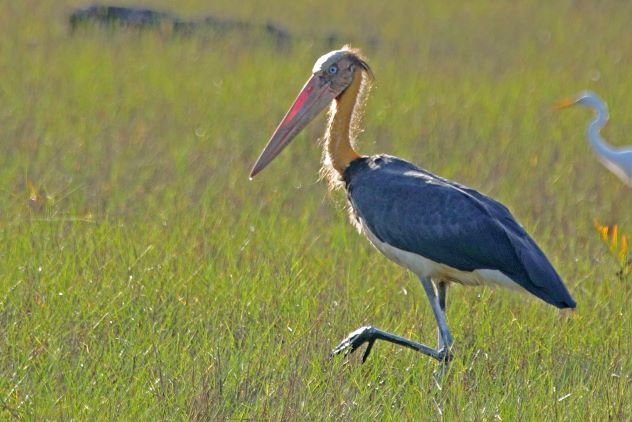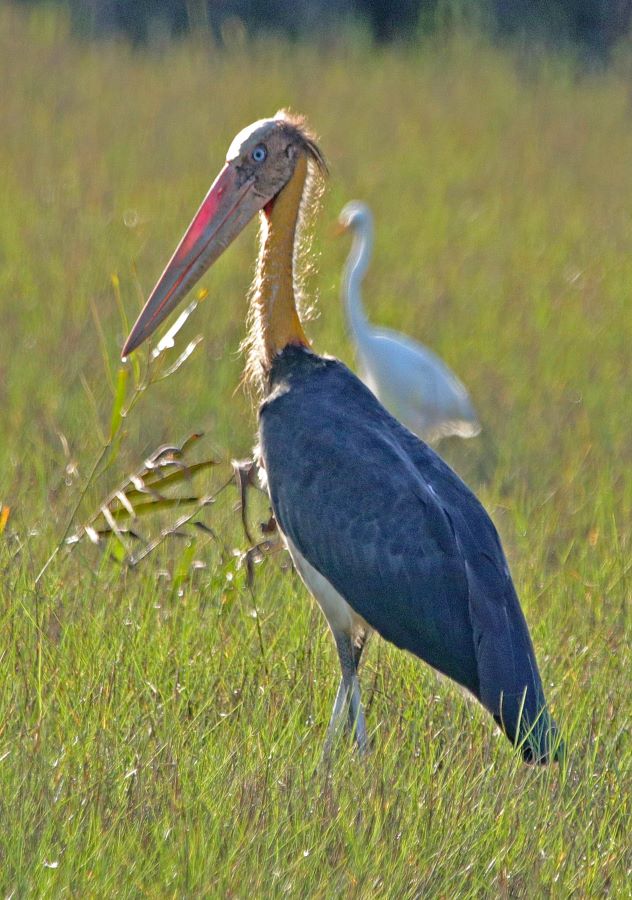It was on the January 1 of this year that I encountered a lesser adjutant (秃鹳 in Chinese or Burung-Botak Kecil in Malay) for the first time in my life at Kuala Baram Wetlands. I viewed that as a great start to 2022!
The Lesser Adjutants (Leptoptilos javanicus) are large wading birds in the stork family Ciconiidae that are found in South and South-east Asia. They have pale, long and thick bills. The upper body and wings are glossy dark grey-black and the underside are white. The yellowish neck and red head are mostly bare and featherless (except for a few scattered hair-like feathers), ideal for their scavenging habits as the neck and head often become covered with blood and other substances when they feed inside corpses. Males and females look alike; except males tend to be larger in size and heavier billed.
Their dark grey legs are often stained white with uric acid as they commonly defecate on them. This is believed to be a cooling measure, as the evaporation lowers their body temperature offering relief when temperatures are uncomfortably high.
These birds are generally solitary and only form groups during the breeding season at which time they will form loose nesting colonies. They are believed to be monogamous – however, they may not always pair for life. The female will lay 1 – 4 (mostly 3) white eggs at intervals of 1 – 3 days. Both parents share the incubation of the eggs for about 28 – 30 days to hatching. The hatchlings are covered with thin grey down and they are brooded for about 12 – 14 days; after the first week, the amount of time spent brooding them decreases gradually. Both parents feed and care for the chicks. During hot weather, they are observed spreading out their wings to shade the chicks. They will also bring water to the nestlings – either for drinking or to cool them down. The young fledge when they are about 47 – 52 days old and are independent when they are about 5 months old.
They are also mostly sedentary within their range, except for local movements in response to rain falls and availability of food.They are found mostly in freshwater wetlands, shallow marshes, fields, swamps, mangroves and mudflats. They feed on fish, frogs, reptiles, locusts and large invertebrates, rodents, young birds and carrion (dead animals).
Lesser Adjutants stand about 43 – 51 inches (110-129 cm) tall, have a wingspan of about 83 inches (210 cm) and weigh about 19.6 lbs (8.9 kg). Their large outstretched wings are perfectly adapted for soaring on thermals.
They are largely silent as they lack vocal muscles but have been noted to clatter their bill, hiss and moan.
They were named “Adjutant” by British Colonial troops based on their slow and stiff “military” gait and their habit of standing motionless for long periods of time reminiscent of officers (or “Adjutants”) standing at attention.
Previously quite common, their numbers are on the decline due to destruction of their habitats and harvesting of their eggs and chicks. Only a few thousand birds are left in the world, mostly in South East Asia.
 CY@CY Says Welcome to my dreamscape. Where a Lim is also a Ling.
CY@CY Says Welcome to my dreamscape. Where a Lim is also a Ling.

